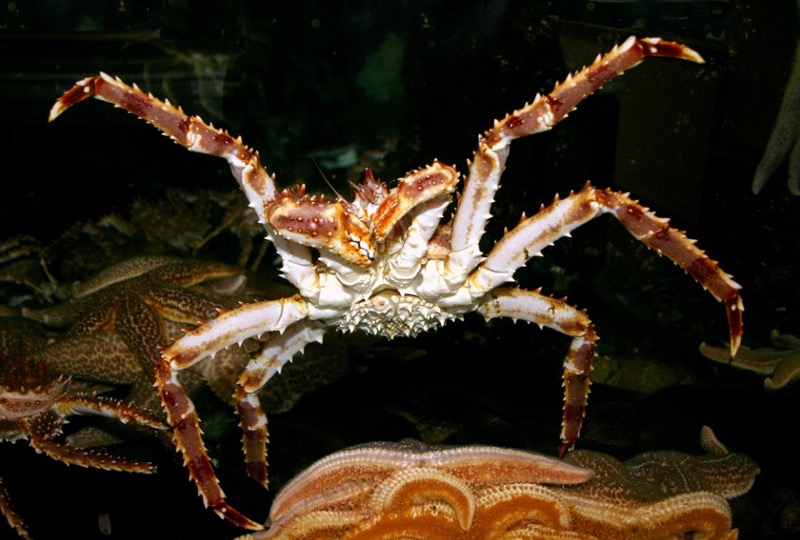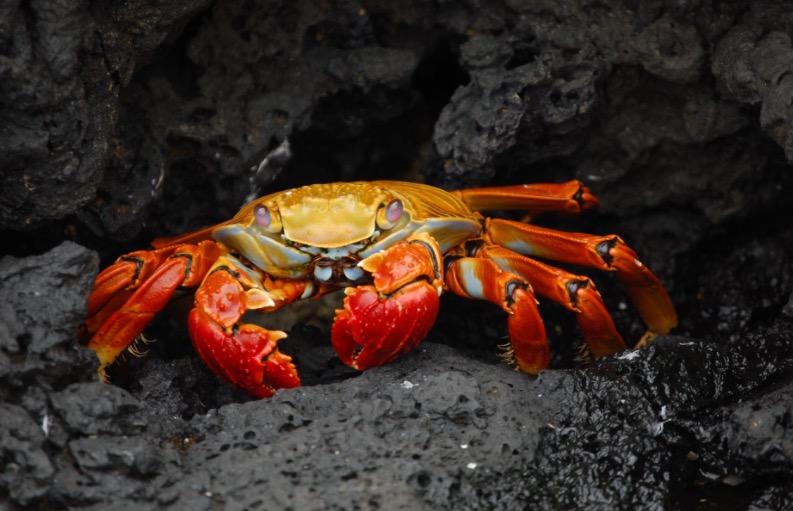Table of Contents
Red King Crab: All You Need To Know
A red king crab is a benthic crustacean that belongs to the kingdom of Animalia, phylum Arthropoda, and class Malacostraca. Its genus is Paralithodes, and its species is P. camtschaticus. Its length is up to 1.8 m, and it weighs about 12.7 kg. It lives in sandy or rocky substrates in cold water, with a lifespan of 20 to 30 years.

What is Red King Crab?
The red king crab, commonly known as the Alaskan king crab or Kamchatka king crab, is the biggest king crab species found in the far northern Pacific. It is well-known for the large-scale fishing that targets this species in this area.
Red King Crab Description
The red king crab is a huge crab with a carapace of 11 inches in diameter and a leg reach of over 6 feet. Males grow to be bigger than females, with the heaviest weighing around 28 pounds. For further protection, it possesses a hard shell or exoskeleton covered in short, stiff spines.

The king crab, like other genuine crabs, prawns, and lobsters, is a decapod with ten legs. They seem burgundy or brown in hue, despite their name, which relates to their colour when cooked.
Red King Crab Distribution and Habitat
Red king crabs are found only in the northern Pacific Ocean. This species was introduced to the Barents Sea in the 1960s and can also be found in the Bering Sea. It prefers cold water, and has been seen in temperatures ranging from 29 to 55 degrees Fahrenheit.
The red king crab prefers shallow waters less than 65 feet deep when it is young. Individuals will typically be found between 65 and 165 feet of water once they reach the age of two. At this point, they will frequently engage in ‘podding,’ in which hundreds of crabs congregate in huge, highly concentrated groups at night.
Because they are not completely developed, this offers them safety from predators. Adult king crabs eventually live in 650-foot-deep seas, on sandy substrates, but they will go to shallower, rocky regions to mate.
Red King Crab Diet and Predators
The red king crab is an omnivore species that eats nearly anything it can get its hands on. Feeding on dead and rotting plant and animal matter, as well as hunting a range of invertebrate species using their front limbs used to grasp and manipulate food and prey, are examples.
The red king crab is preyed upon by a variety of sharks, fish, cephalopods, and whales in its natural habitat. This is primarily determined by their life stage, with larger, more mature crabs being less vulnerable to predation.
In the red king crab’s natural area, the giant pacific octopus is one of the most ferocious crab predators. Humans feed on the red king crab on a daily basis, making it one of the world’s major crab fisheries.
Red King Crab Reproduction
Internal fertilisation occurs in red king crabs, with females brooding fertilised eggs on the underside of their abdomen for up to a year. Individuals will go to shallower areas to mate throughout the winter when the surface waters are suitably chilly.
This migration happens in the case of previously pregnant females in order to spawn, release the young into the water column, and mate once more before withdrawing to deeper waters in the summer. Females will release between 50,000 and 500,000 larval crabs during each spawning episode, which occurs once a year throughout the course of their 20-30 year lifetime.
Red King Crab Conservation
The red king crab is the subject of a vast and profitable fishery that is typically well-managed, with viable populations persisting in most of its native and imported ranges. This species is less damaging than other commercial fisheries since it is usually caught using traps rather than trawling the seabed.
This is assisted even further by the fact that mature individuals of the species prefer sandy ground to rocky substrates or other environmentally sensitive habitats. The species is invasive in several regions of Europe, and it has no specific conservation protection other than protection for the purpose of controlling fisheries.
Fun Facts About Red King Crab!
If you’ve ever eaten ‘king crab legs,’ you’re undoubtedly already familiar with the red king crab. The species, on the other hand, is intriguing and allows us to learn many important facts and biological ideas in addition to just being on our dinner plates as crab legs.
Red King Crab
The Bering Sea and the north Pacific Ocean are home to the red king crab. It did, however, attract the notice of another big red entity in the 1960s. The species was introduced to the Murmansk Fjord, a region of the Barents Sea closer to Europe, by the former Soviet Union. Their mission was to establish a new, viable, and profitable fishing industry in this region.
The initial batch of crabs was transported overland, but they did not make it. Some were flown in instead. These individuals survived and formed a colony in the region, where they are now considered an invasive species.
Red King Crab: Stalin’s Crabs
Although the introduction of some species to new settings may appear harmless at first look, there are frequently unanticipated consequences that can be disastrous to the ecology. The red king crab has caused problems in the Barents Sea, where it was first introduced.
Due to the absence of one of its most important natural predators, the gigantic Pacific octopus, in European seas, this population has expanded virtually uncontrolled for decades and is now very enormous.
The animal will consume practically anything in its path because it is an omnivore. Local fishermen and researchers claim that this is essentially producing “deserts” devoid of native species and life in general.
The species has also reached the Norwegian shore since the 1960s and is moving south at a rate of around 30 miles per year. This has sparked worries that comparable consequences to those seen in the Barents Sea would occur here as well, with particular concern expressed for the cod spawning grounds around Lofoten.
There’s also evidence that the species prefers to eat capelan egg masses, a tiny fish that’s a major food source for cod. As a result of these threats, the locals have begun to demonise the species, referring to them as “Stalin’s Crabs.”
Red King Crab: Molting and Exoskeletons
The red king crab’s shell, like that of all decapods, is a skeleton on the outside of its body. The exoskeleton, in contrast to the endoskeletons seen in humans, does not expand. As a result, individuals must moult or lose their shells on a regular basis in order to become larger.
Before this, a person begins to construct a new, bigger skeleton within the current one. As it becomes larger, the present shell will no longer be able to contain it, causing it to break open.
The new exoskeleton hardens even more when it dislodges itself from the old outer shell. The crab’s new exoskeleton, on the other hand, might stay soft for many days, making it more vulnerable to predation than it would otherwise be.
Red King Crab Doesn’t Hold its Breath
The red king crab, like fish and sharks, has gills that allow it to breathe underwater. Two branchial chambers occur within the carapace, the crab’s main body. Within this chamber, the gills are protected by a strong chitinous cuticle covering that is permeable to gases and allows oxygen to pass through.
The crab utilises a special appendage known as a scaphognathite to guarantee water flow within the branchial chamber. This pulls water in from behind the crab’s walking legs and expels it via prebronchial apertures, which are positioned beside the crab’s mouth.
Red King Crab Citations
- Effects of ocean acidification on juvenile red king crab (Paralithodes camtschaticus) and Tanner crab (Chionoecetes bairdi) growth, condition, calcification, and survival. PLoS One . 2013 Apr 4;8(4):e60959.
- Ration of the red king crab on coastal shoals of the Barents Sea. Dokl Biol Sci . 2015;463:200-4.
- Heavy metals and POPs in red king crab from the Barents Sea. Food Chem . 2015 Jan 15;167:409-17.







